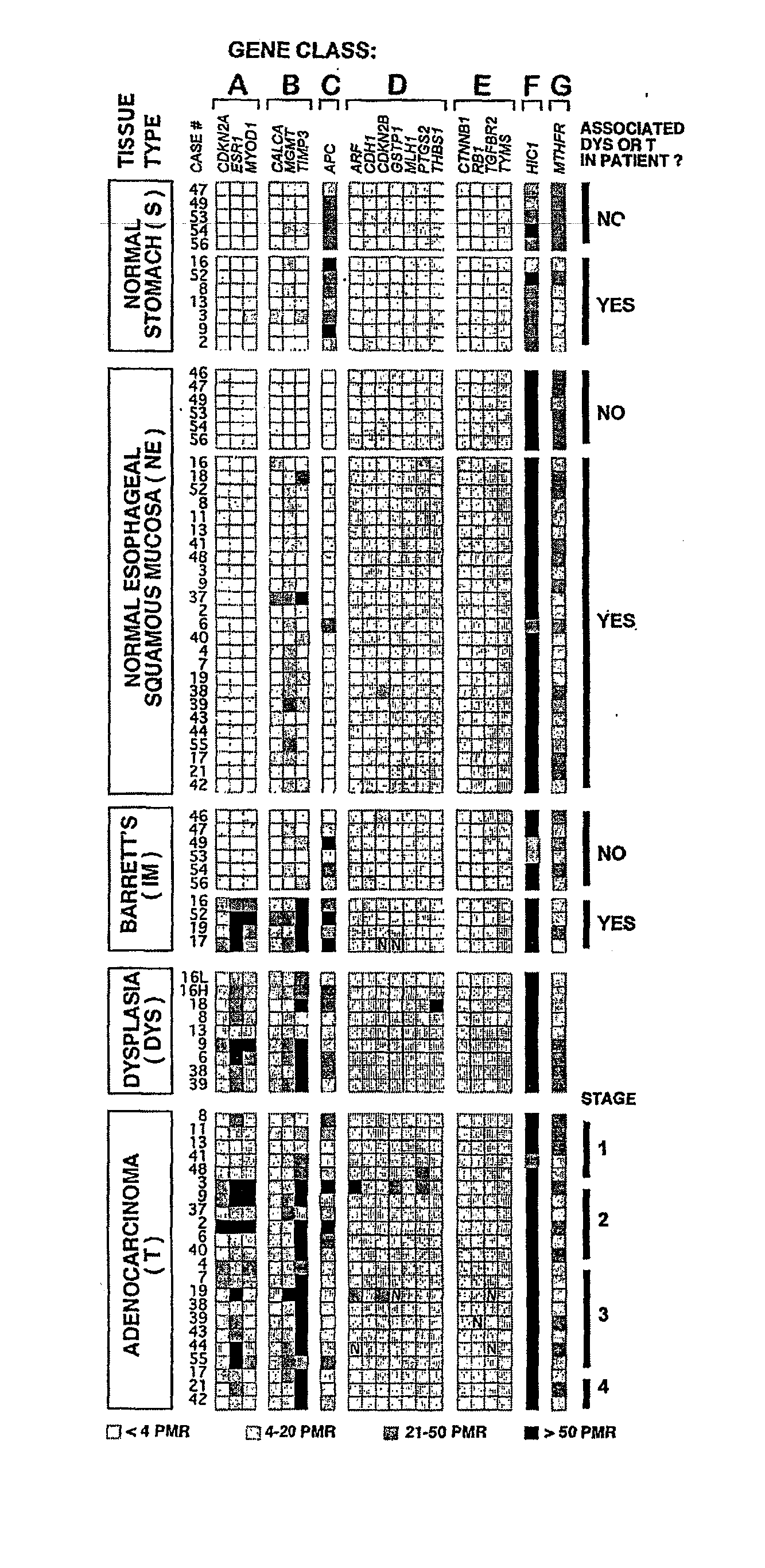Epigenetic sequences for esophageal adenocarcinoma
a technology of esophageal adenocarcinoma and epigenetic sequences, which is applied in the field of esophageal adenocarcinoma, can solve the problems of not providing a suitable diagnostic and/or prognostic framework, the role of the cimp pathway in the tumor evolution of eac is still uncharacterized, and the epigenetic studies of this model have so far been limited
- Summary
- Abstract
- Description
- Claims
- Application Information
AI Technical Summary
Benefits of technology
Problems solved by technology
Method used
Image
Examples
example 1
CpG Island Hypermethylation Increased with the Progression of EAC
[0118] This Example shows the results of an analysis of the methylation status of a panel of CpG islands associated with 19 different genes selected for their known involvement in carcinogenesis or because they have been shown to be methylated in other tumors (see Table 1, and under “Definitions,” above), and of one non-CpG island sequence (MTHFR control sequence), for a total of 20 gene loci.
[0119] Quantitative methylation data of the 20 genes from a screen of 84 tissue specimens from 31 patients with different stages of Barrett's esophagus and / or associated adenocarcinoma showed a general increase in the frequency and in the quantitative level of CpG island hypermethylation at progressively advanced stages of disease. Accordingly, genes were grouped into distinct classes by their methylation behavior, based on both frequency and level of hypermethylation in various tissues (FIG. 1).
Materials and Methods
[0120] Sa...
example 2
Hypermethylation was Reflective of EAC Tumor Grade and Stage
[0156] This Example examines whether the grade or stage of an esophageal adenocarcinoma correlates with a higher frequency of CpG island hypermethylation. According to the present invention, for EAC, epigenetic Class A gene methylation is significantly higher in stage II, III and IV tumors relative to less advanced stage I tumors (FIG. 4).
Materials and Methods
[0157] TNM staging. The American Joint Committee on Cancer (“AJCC”) has designated staging by TNM classification (Tumor; lymph Node metastasis, distant Metastasis). TNM staging was used to classify the stage of each esophageal adenocarcinoma from the tissues of Example 1.
[0158] Methylation and statistical analysis. Methylation and statistical analysis was as described herein under Example 1.
Results
[0159] Methylation of epigenetic Class A genes increases with tumor stage. Moderately differentiated tumors have significantly less frequent Class A methylation compa...
example 3
Methylation of Premalignant Tissues With or Without Associated Dysplasia
[0162] This Example shows that the frequency of Class B methylation in the normal esophagus (NE) was found to be significantly higher in patients with associated dysplasia / tumor (p=0.0037) (FIG. 1). Additionally, Class A methylation was found to be more frequent in IM samples from patients with concurrent dysplasia or cancer, than in IM samples from patients without any evidence of further progression (p<0.0001) (FIGS. 1 and 5). That is, there was a significant positive association between hypermethylation of epigenetic Class A genes in IM tissue, and the presence of associated dysplasia or cancer (FIG. 5).
Materials and Methods
[0163] Histopathology. Histopathological classification was as described under “Materials and Methods,” Example I above.
[0164] Methylation and statistical analysis. Methylation and statistical analysis was as described herein under Example 1.
Results
[0165] Methylation of Premalignan...
PUM
| Property | Measurement | Unit |
|---|---|---|
| Fraction | aaaaa | aaaaa |
| Fraction | aaaaa | aaaaa |
| Fraction | aaaaa | aaaaa |
Abstract
Description
Claims
Application Information
 Login to View More
Login to View More - R&D
- Intellectual Property
- Life Sciences
- Materials
- Tech Scout
- Unparalleled Data Quality
- Higher Quality Content
- 60% Fewer Hallucinations
Browse by: Latest US Patents, China's latest patents, Technical Efficacy Thesaurus, Application Domain, Technology Topic, Popular Technical Reports.
© 2025 PatSnap. All rights reserved.Legal|Privacy policy|Modern Slavery Act Transparency Statement|Sitemap|About US| Contact US: help@patsnap.com



